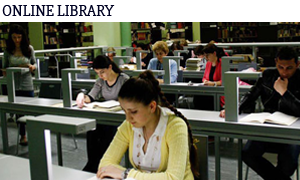
FACULTY OF ECONOMICS AND BUSINESS
Georgian Food Security Strategy
Many problems illustrate the fragility of Georgia’s food security food dependency and the lack of self-sufficiency. The principle issues include weak institutional and legal frameworks regulating food ; no national strategy on food safety and quality; ineffective monitoring services; the diminishing share of agriculture within the total GDP stemming from decreasing agricultural production; low awareness by consumers on food security issues; lack of skilled staff; and the lack of risk management in the food chain. These conclusions were made by TSU Professor Eka Lekashvili according to the results of her research “Concerning the Issue of a Food Security Strategy.” The goal of the research was to identify problematic sectors and identify solutions. The research was conducted in 2011-2012 and results submitted within local and international conferences.
As the author of the research notes, economic factors influencing Georgia’s food security policy were studied according to the following indicators: the minimum subsistence and its ratio to average per capita income; amount and dynamics of food expenses; dynamics of the level of food prices and the ratio of food prices to consumer prices; the share of agriculture in Georgia’s total GDP and its dynamics; and the ratio of Georgia’s food exports to imports.
Export-import: According to the research “Concerning the Issue of a Food Security Strategy”, a significant increase in imports compared to exports confirms that food independence and self-sufficiency remain problematic in Georgia. In 2010, registered food exports amounted to USD 1574.1 million, while imports were USD 5248.5 million. In other words imports are three times more than exports (see Chart 1), or a ratio of 0.33.


In 2005-2011 food accounted for 14% of the country’s total imports.
In 2010 exports of wine amounted to 2.5%; nuts – 4% and alcoholic beverages – 3.4%. During the same year imports of sugar amounted to 1.5%, cigarettes – 1.6% and wheat – 3.4% (see diagrams 2 and 3).
The researcher points out that significant attention should be paid to food independence in the light of the national food security strategy, and that only then could the country discuss appropriate food security measures.
 Quality control: Food safety and quality management are important components of food security policy. According to the legal principles of food safety, foodstuffs should be subject to scientific risk assessments except for cases when external factors or the nature of analysis make it impossible. Food safety and quality should be transparent throughout the entire food chain.
Quality control: Food safety and quality management are important components of food security policy. According to the legal principles of food safety, foodstuffs should be subject to scientific risk assessments except for cases when external factors or the nature of analysis make it impossible. Food safety and quality should be transparent throughout the entire food chain.
According to this research, although food security has been regulated by law since 2005 (Parliament approved the Law of Georgia on Food Safety and Quality on December 27, 2005) its enforcement was postponed to 2013. This shows why regulation has been weak. Quality testing and monitoring foodstuffs since the law came into effect has been crippled by a lack of funding to test samples and conduct laboratory analyses. However, the budgetary funds allocated for test purchases and laboratory analyses are also used poorly. This shows why quality monitoring is poorly carried out and is causing the food market to be swamped with low quality and falsified goods.
Minimum subsistence levels and prices: The energetic value of food defined for a working man during the day in Georgia is extremely low, not exceeding 2300 kilocalories. Almost half of this figure, about 47%, is due to bread and bread products. Meat and meat products, vital for human health, amount to only 6.67% and milk and dairy products compose 8% of the energy value. Over the long term this type of nutrition leads to weakening that leads to incapacitation. This is a clear violation of the universally recognized food security norms (see Charts 4 and 5).
In Georgia the minimum subsistence for the average consumer was GEL 113.4 in December 2010, while the average monthly income was GEL 178.6 the same year. It is quite obvious from these figures that we do not consider the disproportionate distribution of incomes, or the fact that 63% of the population’s per capita monthly incomes were spent on food. The minimum living wage of the average Georgian consumer defined based on the minimum food basket was 113.4 GEL in 2010. The monthly per capita income in Georgia was 178.6 GEL in 2010. These data show that, even if we put the disproportionate distribution of incomes aside, in 2010 63% of the monthly per capita income was spent on the minimum food basket. According to official data, in 2010 total consumer expenses amounted to GEL 255.2 million in urban areas, and GEL 150.4 million in rural areas, of which expenses on food, including alcoholic beverages and tobacco, amounted to GEL 99 million (38%) and GEL 69 million (45.8%), respectively. It is clear that the Georgian population spends a significant part of their income on foodstuffs. Importantly, there are greater hikes in food prices in Georgia compared to other consumer commodities.”
Lack of awareness: Because of a lack of family income most of the population focuses on price rather than on quality. Even if consumers wish to judge food quality, they have not been educated in quality issues and lack the skills necessary to evaluate quality. They remain oriented only by their own experience and knowledge. This lack of consumer and producer awareness in Georgia significantly exacerbates the food security problems. Food security must be ensured equally by all participants in the food process: producers, technologists, distributors, consumers and government.
 While analyzing the food security problems, the study also discusses demographic issues, and in particular the fact that almost half of the Georgian population is employed in agriculture (46.9%). There is a tendency towards a slight reduction in these percentages which can only partially be attributed to by migration and urbanization.
While analyzing the food security problems, the study also discusses demographic issues, and in particular the fact that almost half of the Georgian population is employed in agriculture (46.9%). There is a tendency towards a slight reduction in these percentages which can only partially be attributed to by migration and urbanization.
Recommendations: The author of the research, explained that Georgia’s food security strategy should first and foremost be directed to the development of the agricultural sphere because without food independence or self-sufficiency it will be impossible to achieve food security. For this, the following measures should be implemented: create an attractive agricultural environment for business; attract investments for the development of agriculture to rehabilitate the infrastructure, irrigation and melioration systems, agricultural machinery, storage and processing areas and to provide relevant services for farmers; as well as fuel and fertilizer supplies. It is also essential to develop a real agro-industrial sector by training qualified staff and conducting scientific research; to prevent the spread of epidemics in plant-growing and cattle-breeding; to make agricultural loans available for farmers; to create an insurance system in agriculture; perfect cultivation of agricultural land funds; to supply farmers with high quality seeds; to introduce tax benefits; to consult farmers on modern agricultural achievements; to conduct efficient food quality control to make Georgian products competitive on local and international markets and to increase incomes; to make investments in a reliable, professional and transparent system of laboratories that represents a key element of food safety and quality system. Georgian food security policy should be oriented towards the development of a food market through producing competitive goods that meet international standards. They must, finally, improve production management and technical and legal issues, including domestic market risks.




